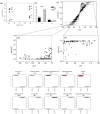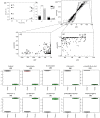Characterization of Cultivar Differences of Blueberry Wines Using GC-QTOF-MS and Metabolic Profiling Methods
- PMID: 30227669
- PMCID: PMC6225290
- DOI: 10.3390/molecules23092376
Characterization of Cultivar Differences of Blueberry Wines Using GC-QTOF-MS and Metabolic Profiling Methods
Abstract
A non-targeted volatile metabolomic approach based on the gas chromatography-quadrupole time of fight-mass spectrometry (GC-QTOF-MS) coupled with two different sample extraction techniques (solid phase extraction and solid phase microextraction) was developed. Combined mass spectra of blueberry wine samples, which originated from two different cultivars, were subjected to orthogonal partial least squares-discriminant analysis (OPLS-DA). Principal component analysis (PCA) reveals an excellent separation and OPLS-DA highlight metabolic features responsible for the separation. Metabolic features responsible for the observed separation were tentatively assigned to phenylethyl alcohol, cinnamyl alcohol, benzenepropanol, 3-hydroxy-benzenethanol, methyl eugenol, methyl isoeugenol, (E)-asarone, (Z)-asarone, and terpenes. Several of the selected markers enabled a distinction in secondary metabolism to be drawn between two blueberry cultivars. It highlights the metabolomic approaches to find out the influence of blueberry cultivar on a volatile composition in a complex blueberry wine matrix. The distinction in secondary metabolism indicated a possible O-methyltransferases activity difference among the two cultivars.
Keywords: GC-QTOF-MS analysis; blueberry wine; multivariate analysis; volatile composition.
Conflict of interest statement
The authors claim no conflict of interest.
Figures




Similar articles
-
Aroma active volatiles in four southern highbush blueberry cultivars determined by gas chromatography-olfactometry (GC-O) and gas chromatography-mass spectrometry (GC-MS).J Agric Food Chem. 2014 May 21;62(20):4537-43. doi: 10.1021/jf500315t. Epub 2014 May 6. J Agric Food Chem. 2014. PMID: 24758568
-
Differentiation of wines according to grape variety and geographical origin based on volatiles profiling using SPME-MS and SPME-GC/MS methods.Food Chem. 2016 Dec 15;213:714-720. doi: 10.1016/j.foodchem.2016.06.120. Epub 2016 Jul 1. Food Chem. 2016. PMID: 27451239
-
Effectiveness of high-throughput miniaturized sorbent- and solid phase microextraction techniques combined with gas chromatography-mass spectrometry analysis for a rapid screening of volatile and semi-volatile composition of wines--a comparative study.Talanta. 2012 Jan 15;88:79-94. doi: 10.1016/j.talanta.2011.10.010. Epub 2011 Oct 17. Talanta. 2012. PMID: 22265473
-
Regional features of northern Italian sparkling wines, identified using solid-phase micro extraction and comprehensive two-dimensional gas chromatography coupled with time-of-flight mass spectrometry.Food Chem. 2016 Oct 1;208:68-80. doi: 10.1016/j.foodchem.2016.03.112. Epub 2016 Mar 30. Food Chem. 2016. PMID: 27132825
-
[Predicting the Pharmacologic Activity of Natural Materials Based on Metabolomics].Yakugaku Zasshi. 2020;140(10):1251-1258. doi: 10.1248/yakushi.20-00165. Yakugaku Zasshi. 2020. PMID: 32999204 Review. Japanese.
Cited by
-
Enhancing blueberry wine aroma: Insights from cultivar selection and berry sorting.Curr Res Food Sci. 2023 Nov 19;7:100643. doi: 10.1016/j.crfs.2023.100643. eCollection 2023. Curr Res Food Sci. 2023. PMID: 38077470 Free PMC article.
-
Modeling and application of sensory evaluation of blueberry wine based on principal component analysis.Curr Res Food Sci. 2022 Nov 30;6:100403. doi: 10.1016/j.crfs.2022.11.022. eCollection 2023. Curr Res Food Sci. 2022. PMID: 36479228 Free PMC article.
-
NOREVA: enhanced normalization and evaluation of time-course and multi-class metabolomic data.Nucleic Acids Res. 2020 Jul 2;48(W1):W436-W448. doi: 10.1093/nar/gkaa258. Nucleic Acids Res. 2020. PMID: 32324219 Free PMC article.
-
Editorial to the Special Issue-"Technology for Natural Products Research".Molecules. 2020 Jan 14;25(2):327. doi: 10.3390/molecules25020327. Molecules. 2020. PMID: 31947506 Free PMC article.
-
Selective Wine Aroma Enhancement through Enzyme Hydrolysis of Glycosidic Precursors.Molecules. 2023 Dec 19;29(1):16. doi: 10.3390/molecules29010016. Molecules. 2023. PMID: 38202600 Free PMC article.
References
-
- Kalt W., McDonald J., Donner H. Anthocyanins, phenolics, and antioxidant capacity of processed lowbush blueberry products. J. Food Sci. 2000;65:390–393. doi: 10.1111/j.1365-2621.2000.tb16013.x. - DOI
-
- Seeram N.P., Adams L.S., Zhang Y., Lee R., Sand D., Scheuller H.S., Heber D. Blackberry, black raspberry, blueberry, cranberry, red raspberry, and strawberry extracts inhibit growth and stimulate apoptosis of human cancer cells in vitro. J. Agric. Food Chem. 2006;54:9329–9339. doi: 10.1021/jf061750g. - DOI - PubMed
MeSH terms
Substances
Grants and funding
LinkOut - more resources
Full Text Sources
Other Literature Sources
Miscellaneous

